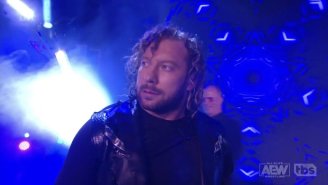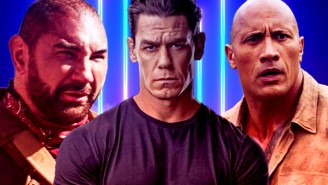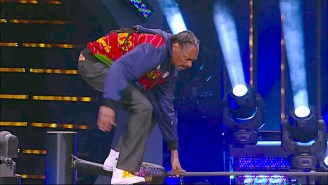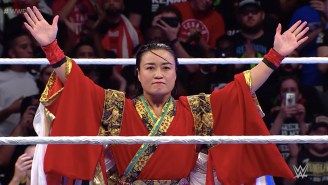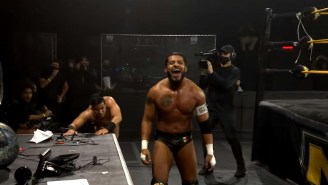Ric Flair’s 30 For 30 documentary “Nature Boy” bowed last week, and was met with incredible acclaim. The documentary was spectacularly well-made, and featured some of the most up-front and candid moments the two-time Hall of Famer has ever allowed to be captured on video.
The doc did a lot of things right, as is the case for the vast majority of the subjects that the prestige ESPN series tackles. One of the best things the documentary did, which pro wrestling documentaries often fail to get across, is the vast difference in viewership, aesthetic, and ethos between WWF and the NWA during Ric Flair’s heyday.
Of course, there was a lot of stuff that was also left out of the documentary, because documentaries are rarely perfect, and almost never have time to tell the complete tale. (Particularly a tale as long-running as Flair’s.) We’re also still awaiting an André the Giant documentary that is coming from HBO and Bill Simmons, just one of a slew of biographical projects about André that are in the works.
Flair is the first pro wrestling subject to get the feature-length 30 For 30 treatment. There was a spectacular E:60 short-form documentary about Scott Hall some years back, as well as a 30 For 30 short about the Von Erich family. But if the reception of the Flair doc is any indication, there will likely be another pro graps 30 For 30 one day.
30 For 30 rarely shies away from serious subjects — in fact, they’re often the series’ bread and butter, much like a sports version of Behind the Music, but much classier. To that end, I wouldn’t be surprised of the next pro wrestling 30 For 30 subject was Chris Benoit, or perhaps Chyna.
The truth is there are a million wrestlers, events, and stories in pro wrestling worthy of the 30 for 30 treatment, but I expect that only a few of them will ever get made. Here is a very, very, very short list of some of the most vital and interesting stories in wrestling’s history that will never see the light of day.
Who Killed Brody?
On July 16, 1988, Bruiser Brody was wrestling in Puerto Rico, when he was asked by booker José Huertas González to step into the shower area to go over some things. Screams rang through the locker room, and Tony Atlas ran over to find Brody had been stabbed, and González was holding a knife. The paramedics were delayed in getting Brody to the hospital, and the massive wrestler later died from his wounds. González, who wrestled as Invader 1, was acquitted of murder on the grounds of self-defense, but the incident sparked bad blood for decades to come.
Since his death, Brody has inspired legions of pro wrestlers, and became one of pro wrestling’s greatest what-if stories, never having the chance to realize his full potential in the business. A deep, documentarian dive into the story would be enthralling for even non-fans, and is a tragedy still very much worth examining from a journalistic perspective. Like so many other tragedies in pro wrestling, this doesn’t get the attention it deserves.
The True Story Of Fabulous Moolah
I’ll let With Spandex’s own Danielle Matheson explain:
If we truly are entering a period of letting down our hair and shaking loose all of the entertainment industry’s dark secrets, then, at some point, we need to be open and honest about The Fabulous Moolah.
While WWE paints a picture of one of the greatest female wrestlers of all time, the truth is that Moolah did just as much to hold back the progress of women in wrestling as any of her male counterparts. Multiple trainees have accused her of financial abuse at best, and sexual abuse and assault at worst. The territories are littered with stories of her using young trainees as sexual currency with wrestling promoters. She used her position to extort money from female performers, and strictly controlled how anyone willing to perform with her was booked. As Velvet McIntyre’s WrestleMania 2 match shows, this was not for their own benefit.
Sadly, given how propped up her legacy is, and WWE’s current relationship with ESPN, we’ll probably never see a real exploration of her past.
Exotic Adrian Street And The History Of The Gay Panic Wrestler
The tradition of the “gay panic” wrestling character likely stretches back even farther than Gorgeous George, who may not have exactly been a gay panic character, but certainly reaped some heat from homophobic fans. For those unfamiliar, a gay panic character (not just exclusive to pro wrestling), is an over-the-top and flamboyant fop or dandy, designed to spark a deep hatred in the viewer by sheer dint of being “other.” Someone who has the audacity (in the bigoted viewer’s eyes) to flaunt their homosexuality, or otherness.
While not the first, and far from the most well-known gay panic wrestler, arguably no one ever did it better than “Exotic” Adrian Street. The Welsh wrestler, always told he was too small to make it in the business, Street developed his “Exotic” character late in his career, and played it to the hilt, kissing opponents, putting makeup on his unconscious victims, and writing and recording entrance songs long before most wrestlers were entering to music at all. If you think the song “Sweet Transvestite With A Broken Nose” didn’t rile up people in the heartland, you’ve got another thing coming.
The gay panic wrestler (and in South America, the related exotico) has touched pretty much every wrestling company, from “Adorable” Adrian Adonis, to Lenny and Lodi in WCW, to the Christopher Street Connection in Ring of Honor, it’s an ugly and undeniable part of pro wrestling’s history. I’d watch a documentary about that any time someone wants to make it.
Rikidozan
One of the biggest stars in the history of Japanese wrestling, Rikidozan fought an uphill battle from the start. Korean by birth, he was heavily discriminated against, and may have even been drummed out of the sport of sumo as a result of his heritage. He eventually became not only a wrestling star, but a national hero to the Japanese people.
He reached the top of the mountain and became the biggest wrestler in the country, and had hour-long battles against Lou Thesz for the NWA World Heavyweight Championship. Unfortunately, he died at the very young age of 39, when he was stabbed in a nightclub by a yakuza member with a urine-soaked knife. Rikidozan refused medical treatment and died of an infection a week later. His murderer served a seven-year prison sentence, and after he got out, visited Rikidozan’s grave every year on the anniversary of his death. You’re telling me THAT isn’t worthy of a scene near the end of a 30 For 30?
The Continually Employable Vince Russo
This one is probably a long shot, but that doesn’t mean it’s not a hell of an interesting story. Originally a radio personality, he became a longtime writer for WWE’s newsletter and magazine, and eventually the head writer during the boom of the Attitude Era. Russo’s “crash TV” and taboo storylines were considered revolutionary, and he was credited with much of the success WWE had as stars like Steve Austin and the Rock became household names and pop culture phenomenons.
In 1999, Russo and his majordomo Ed Ferrara jumped ship to the competition, WCW, and completely overhauled that company in his image. The storylines were largely universally reviled, and Russo quickly became not only an on-camera character, but the focal point of the promotion. He made a whole lot of enemies and rubbed a whole lot of people the wrong way, and his contract was bought out before WCW eventually folded.
That didn’t stop wrestling companies from continuing to give him jobs, however. He was with TNA from 2002 to 2004, then again from 2006 to 2012, and then AGAIN hired in secret in 2013. He may have even still been working there, again on the sly, before the company was sold last year. This isn’t even counting the companies that Russo started himself after finding backers, and other one-off promotions and startups that opted to hire the controversial writer. An examination of this nearly universally-hated cult of personality would be fascinating, and not just because the interviews with Russo for the documentary would set the land-speed record for “bro”s per minute on ESPN.

